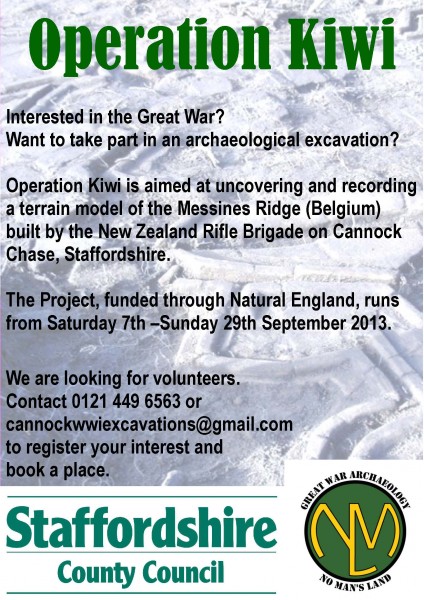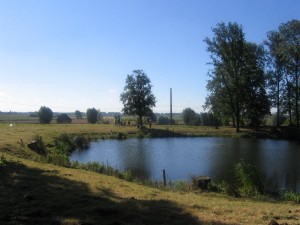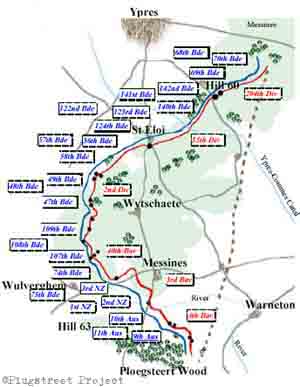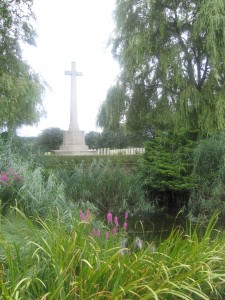Sponsored by
We are currently seeking a sponsor for this website
as it follows the progress of the excavations on the battlefield, with contributions from established historians and well known experts, as the team attempt to match the historical evidence and family history to the archaeology on the ground.
If you enjoy this website
please consider making a donation towards the costs of the project.

|
Zero Hour Wednesday, June 7th, 2017
|
|
|
|
|
The minute hands of the synchronised watches were carefully watched as they ticked down to 3.10am. As each reached the appointed time the Officer or NCO of the Royal Engineers pressed the plunger, sending an electrical charge along the wires that led from his position in the trenches close to the tunnel entrance, down the dark shaft and along underground tunnels, through the sandbags of the tamping and into the cache of explosives.
The delay was minuscule, each of the nineteen mines bust through the surface, a huge column of fire and earth, taking with them all that was situated above them.
In front of Plugstreet Wood the square of red brick buildings named Factory Farm, vanished from existence, along with the concrete bunker which had been built in their midst. Opposite the farm gate the earth was sent skywards, taking with it another bunker which had commanded the slight rise. As the blue clay and concrete, bricks, timber, ironwork, weapons and victims began to fall back to earth, the 33rd Battalion rose to their feet and set out to capture their objective.
|
|
|
|
|
|
Filed under: Great War History by
PlugStreetTeam
Add a Comment »
|
|
Before the Attack Wednesday, June 7th, 2017
|
|
|
|
|
Through the darkness, men of the 9th Brigade, including 33rd Battalion AIF made their way towards the jumping off points. The artillery were very active and as the men moved through the last few yards of Plugstreet Wood, gas shells rained down. Respirators were hastily donned, but for some it was too late.
Those who lost their lives before they had even reached the front line lie side by side in Toronto Avenue Cemetery, a quiet cool place beneath the shady trees that have regrown around the small plot. The headstones close together display their names and some a brief inscription chosen by those back home.
|
|
|
|
|
|
Filed under: Great War History by
PlugStreetTeam
Add a Comment »
|
|
Ready Tuesday, June 6th, 2017
|
|
|
|
|
At 4pm the sealed orders for the detonation of the mines were handed to the officers in charge of each, these were accompanied by a pocket watch, the time already synchronized to time the count down. At Ontario Farm the situation was still critical, the engineers working through the night to lay replacement firing wires to ensure their charge would blow on command. Above them the New Zealanders slipped into position ready to make the assault up the steep slope, the town above already pounded almost to rubble by the artillery.
After a final review of the plans for the attack, 33rd Battalion AIF left their billets at Neippe and moved by companies up to the front line at St Yves, each took a different route, moving in silence through the darkness. They were on the right flank of the attack, right along the line, the attacking units moved forward to take up their places.
Far to the south, near Arras a diversionary attack was taking place, hoping to distract enemy attention from the build up of troops in front of Messines Ridge.
|
|
|
|
|
|
Filed under: Great War History by
PlugStreetTeam
Add a Comment »
|
|
Trench Raids Monday, June 5th, 2017
|
|
|
|
|
On the final day of preparation for the attack trench raids we carried out to assess the effectiveness of the artillery and the situation in the enemy trenches. In the Australian sector 33rd, 37th, 40th, 42nd and 43rd Battalions send parties out in the early hours of the morning.
The men from C Company, 33rd Battalion climbed silently out of the trenches by the road at St Yves, not far from the place where our team excavated the British Bunker. The short distance across No Man’s Land was successfully negotiated and they entered the enemy trenches just north of where the Ultimo Mine waited deep beneath the clay. The front line trenches were deserted, the party explored around 50 yards of the same trenches we have been exploring, but were unable to find their main objective. The party were tasked with locating the entrance to a suspected counter tunneling shaft, if the enemy tunnelers had also planted explosives beneath the Belgian blue clay, they were liable to trigger them in the opening of the battle and the results could have been devastating for the advancing Australians.
It would be over 90years before the presence of the suspected shaft was confirmed, the bulky notched timbers, knocked askew by the force of the explosion which created Ultimo Crater, next saw the light of day when our team uncovered them.
The Allied Artillery conducted a practice barrage at 3 p.m. and another at 8 p.m. In retaliation the enemy guns bombarded the rear areas, aiming to silence the guns. A enemy shell landed in Bailleul Station, blowing up a Ammunition train, bringing in much needed ammunition for the Allied guns.
The time for Zero hour was revealed to those who needed to know, 3.10am on the 7th of June.
|
|
|
|
|
|
Filed under: Archaeology, Great War History by
PlugStreetTeam
Add a Comment »
|
|
Dress Rehearsal Saturday, June 3rd, 2017
|
|
|
|
|
As the Sappers deep beneath The Caterpillar began the final tamping of the tunnel leading to the mine chamber, shells rained down on the ground above. The roar from over two thousand artillery pieces echoed across the plains of Flanders as the gunners worked furiously to keep up the allotted rate of fire. Above the ridge, aircraft of the Royal Flying Corps reported back to their operators the locations of enemy guns as they returned fire. Three miles behind the lines those manning the eight captive Balloons observed the artillery from 5,000 feet as the creeping barrage swept forward.
In the German lines, the men steeled themselves for an attack, but all fell silent once more.
|
|
|
|
|
|
Filed under: Great War History by
PlugStreetTeam
Add a Comment »
|
|
100 Years Ago Today Thursday, June 1st, 2017
|
|
|
|
|
100 years ago today on the 1st of June 1917 preparations for the planned attack were well underway. As the men of the infantry units rehearsed the action over practice trenches in the training areas, the artillery were already in action. Across the front line, the German artillery responded, shelling a wide area, reaching well behind allied lines.
33rd Battalion AIF were billeted at Nieppe, in addition to their intense training schedule, they supplied working parties to assist with preparations.
|
|
|
|
|
|
Filed under: Great War History by
PlugStreetTeam
Add a Comment »
|
|
Operation Kiwi Monday, October 13th, 2014
|
|
|
|
|
We are very pleased to announce that a DVD recording the work undertaken by the team during Operation Kiwi, the excavation of the Terrain Model of Messines on Cannock Chase is now available at at cost of £15 + £2 p&p for delivery to a UK address or £15 + £5 p&p for delivery outside the UK.
_
Told in three parts of 50 minutes each, experts, volunteers and locals reveal the story of the model from its construction, through its use as a tourist attraction to the 2013 excavations and the landscape over which the Battle of Messines was fought in 1917. Created as part of the process of recording the excavations and research, this is a non profit product and is only available in the PAL format. (Europe, New Zealand, Australia).
_
_
_
|
|
|
|
|
|
Filed under: A Dig Diary, Great War History by
PlugStreetTeam
Add a Comment »
|
|
Operation Kiwi Tuesday, August 13th, 2013
|
|
|
|
|
For our 2013 Season we will be undertaking work a little closer to home, but with a strong link to our work at Plugstreet. Between the 7th and 29th of September 2013, No Man’s Land will be working with Staffordshire County Council to excavate the Messines Model on Cannock Chase.
During the Great War significant training camps and attendant facilities were established on Cannock Chase. These included two Divisional training camps, roads, railways, power station, ranges, training trenches and instructional models.
One of the most unusual Great War features identified is a scale model of a sector of the Western Front. Such models are known from Allied Reserve areas where they were used for instructional purposes ahead of an offensive. A well-known example was created south of Ypres in advance of the 1917 Battle of Messines, and the Australian War Memorial holds a number of photographs of troops inspecting the model. A second example is said to have been created ahead of the Battle of Cambrai (Peter Simkins, pers. comm.) also from 1917. However, neither model is believed to have survived and, more significantly, no other examples are known from the UK.
The Cannock model is believed to have been constructed by members of the New Zealand Rifle Brigade (NZRB) who captured the village of Messines during the battle. The model is known to have survived into the inter-war years when it became a tourist attraction with an attendant who acted as guide to the site. With the onset of World War II, and the return of military training to the Chase the site became overgrown and was lost.
We are looking for volunteers to join us for this unique opportunity, please telephone 0121 449 6563 or email cannockwwiexcavations@gmail.com to register your interest and book a place.

|
|
|
|
|
|
Filed under: Archaeology, Great War History by
admin
Add a Comment »
|
|
94th Anniversary of the Battle of Messines Tuesday, June 7th, 2011
|
|
|
|
|
Ninety Four Years ago today the Allied forces launched the opening attack of the Battle of Messines. Many months of hard dangerous work by the Tunnelling Companies of the Royal Engineers along with careful planning and preparation by all involved led to a successful attack.
_
 Ultimo Crater, the result of the explosion of just one of the mines beneath the German Front Line.
_
The objective of the battle was to push back the enemy from a curving front line, which had barely moved since the trenches were established in the later stages of the Battle of Ypres in late summer of 1914. By straightening the front line between Ypres and Armentieres, the Allies gained control of the higher ground of the Messines Ridge, including the towns of Messines and Wytschaete and the infamous Hill 60, leaving them in a strong position for the planned Third Battle of Ypres, more commonly known as Passchendaele.
_
 Objectives of The Battle of Messines
_
This map shows the curving front line, with the objective shown in black dots.
Although the Battle was a success, many casualties were suffered on both sides. The tactic of exploding massive mines beneath the German front lines, inevitably caused thousands of deaths, and many more were injured or killed as the infantry advanced to capture objectives.
_
As the Team prepares for the 2011 field work, we remember on this day those who took part in the battle.
_
 The Cross of Sacrifice at Prowse Point
_
Please see our History Section for more details of the battle and those who fought in these fields.
|
|
|
|
|
|
Filed under: Great War History by
PlugStreetTeam
Add a Comment »
|
|
|
|
|
|